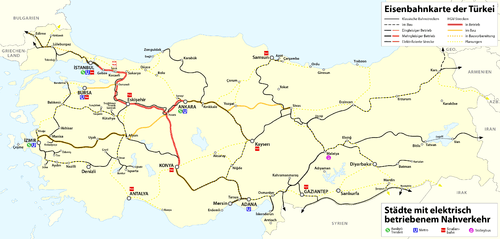Ankara–Istanbul high-speed railway
| Ankara–Istanbul high-speed railway | |
|---|---|
|
A westbound train waiting to depart Ankara Central Station | |
| Overview | |
| Type | High-speed rail |
| System | Turkish State Railways |
| Status | Operational |
| Locale | Central Anatolia |
| Termini |
Ankara Pendik, Istanbul Istanbul Haydarpaşa Terminal Future |
| Stations |
10 12 Future |
| Operation | |
| Opened |
13 March 2009 (Ankara-Eskişehir) 25 July 2014 (Eskişehir-Istanbul) |
| Owner | Turkish State Railways |
| Operator(s) | Turkish State Railways |
| Depot(s) |
Güvercinlik Yard New Ispartakule Yard Future |
| Rolling stock | HT65000 |
| Technical | |
| Line length | 533 km (331.19 mi)[1] |
| Number of tracks | Double track |
| Track gauge | 1,435 mm (4 ft 8 1⁄2 in) standard gauge |
| Minimum radius | 3 500 m |
| Electrification | 25 kV, 50 Hz AC Overhead line |
| Operating speed | 250 km/h (160 mph)[1] |
| Maximum incline | 16 ‰ |
The Ankara–Istanbul high-speed railway (Turkish: Ankara–İstanbul yüksek hızlı demiryolu), is a 533 km (331 mi) long high-speed railway currently running between Ankara and Pendik (a suburb of Istanbul), with the Pendik-Central İstanbul part under construction.
History

Construction on the route is taking place in two phases. The first phase is a 251 kilometres (156 mi), $747 million route between Sincan (a district of Ankara) and İnönü, for which construction began in 2003 on a segment between Esenkent and Eskisehir; this segment was completed in 2007.[1] Regular service between Ankara and Eskisehir began on 13 March 2009.[2] Two shorter lines complete the first phase: a line between Eskisehir and Inonu began construction in 2008 and was completed in 2010, and a line between Sincan and Esenkent was built in 2008.[1]
The second phase, between İnönü and Pendik, is about 214 kilometres (133 mi) long, and costs $2.27 billion.[1] The substantially higher price of the second phase is due to more challenging terrain than the first, including 33 bridges and 39 tunnels.
The section between Inonu and Pendik (a suburb on the Asian side of Istanbul) was opened by the prime minister on 25 July 2014, with the service between Istanbul (Pendik) and Ankara taking 3.5 hours. The service started with six departures daily in both directions.[3] The line will continue into central Istanbul when the Marmaray project is completed in approximately 2018.[4] Until the high speed line is fully completed, the high speed trains will use conventional line on some parts of the route (between Sapanca and Alifuatpaşa. The line is planned to be completed fully in 2016, and the total budget is expected to reach 8.8 billion TL.[5]
Construction is partially financed through foreign sources, including €1.25 billion from the European Investment Bank and €120 million from the European Union.[6]
The China Railway Construction Corporation and the China National Machinery Import and Export Corporation won the bid in 2005 to build the railway line in partnership with two Turkish companies, Cengiz Construction and Ibrahim Cecen Ictas Construction. The project was financed in part by a $750 million loan granted to Turkey by China.
Infrastructure, sections and speeds
| Section | Length | Max Speed | Notes |
|---|---|---|---|
| Ankara Central - Sincan | 24 km | 140 km/h | To be rebuilt as part of the Başkentray project |
| Sincan - Polatlı | 69 km | 250 km/h | |
| Polatlı - Eskişehir Central | 152 km | ||
| Eskişehir Central - Vezirhan | 92 km | One tunnel is incomplete making two others unusable and reducing the speed due to the by-pass | |
| Vezirhan - Köseköy | 96 km | The section between Alifuatpaşa and Sapanca (~23 km) is still under construction and is by-passed with the existing conventional railway line | |
| Köseköy - Gebze | 56 km | 160 km/h | |
| Gebze - Haydarpaşa Terminal | 44 km | 100 km/h | Partly under construction as part of the Marmaray project |
Alcatel won an $80 million contract to supply signalling services on the line, as well as interlockings and control systems,[1] while Thales Group has been contracted to supply an ETCS train control system for the Sincan—Eskisehir portion of the route.[7]
See also
References
- 1 2 3 4 5 6 "Ankara-Istanbul High-Speed Train Project, Turkey". Railway Technology. Archived from the original on 19 December 2011. Retrieved 19 December 2011.
- ↑ "Turkey's First High-Speed Train Service to Begin Next Month". Turkish Weekly. 25 February 2009. Archived from the original on 19 December 2011. Retrieved 19 December 2011.
- ↑ Uysal, Onur. "New Schedule for Istanbul-Ankara High Speed Train", Rail Turkey, 9 August 2014
- ↑ Acar, Cihan, "Istanbul Railway ‘project of the century’ in epic delays", RZD-Partner, 18 February 2015
- ↑ Uysal, Onur."5 Billion Needed Annually for High Speed Trains", Rail Turkey, 30 January 2014
- ↑ "EIB loans €400m for Istanbul-Ankara high speed rail line". Rail.co. 19 December 2011. Archived from the original on 19 December 2011. Retrieved 20 December 2011.
- ↑ "Thales to upgrade Turkish high speed line to ETCS Level 2". Railway Gazette. 2 February 2012. Archived from the original on 14 February 2012. Retrieved 15 February 2012.